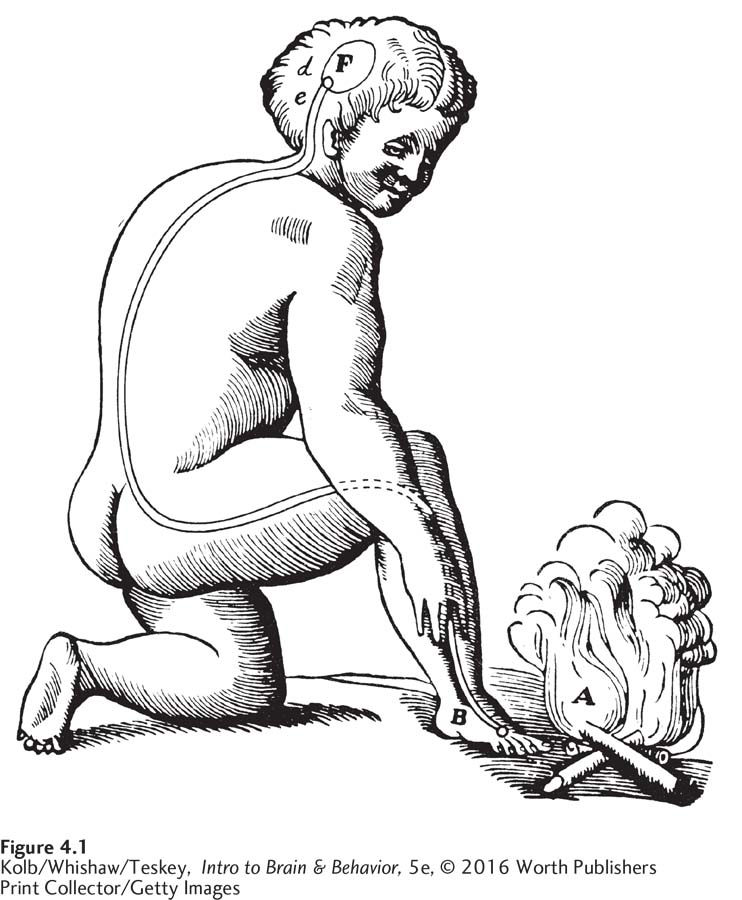Chapter Introduction
How Do Neurons Use Electrical Signals to Transmit Information?
CLINICAL FOCUS 4-
EARLY CLUES THAT LINKED ELECTRICITY AND NEURONAL ACTIVITY
THE BASICS ELECTRICITY AND ELECTRICAL STIMULATION
TOOLS FOR MEASURING A NEURON’S ELECTRICAL ACTIVITY
HOW ION MOVEMENT PRODUCES ELECTRICAL CHARGES
RESTING POTENTIAL
MAINTAINING THE RESTING POTENTIAL
GRADED POTENTIALS
ACTION POTENTIAL
NERVE IMPULSE
REFRACTORY PERIODS AND NERVE ACTION
SALTATORY CONDUCTION AND THE MYELIN SHEATH
CLINICAL FOCUS 4-
EXCITATORY AND INHIBITORY POSTSYNAPTIC POTENTIALS
EXPERIMENT 4-
SUMMATION OF INPUTS
VOLTAGE-
THE VERSATILE NEURON
RESEARCH FOCUS 4-
HOW SENSORY STIMULI PRODUCE ACTION POTENTIALS
HOW NERVE IMPULSES PRODUCE MOVEMENT
CLINICAL FOCUS 4-

4-1
Epilepsy
J. D. worked as a disc jockey for a radio station and at parties in his off-
About one o’clock in the morning, J. D. suddenly collapsed, making unusual jerky motions, then passed out. He was rushed to a hospital emergency room, where he gradually recovered. The attending physician noted that he was not intoxicated, released him to his friends, and recommended a series of neurological tests for the next day. Neuroimaging with state-

When the electrical activity in J. D.’s brain was recorded while a strobe light was flashed before his eyes, an electroencephalogram, or EEG, displayed a series of abnormal electrical patterns characteristic of epilepsy. The doctor prescribed Dilantin (diphenylhydantoin), an antiseizure drug, and advised J. D. to refrain from drinking alcohol. He was required to give up his driver’s license to prevent the possibility of an attack while driving. And he lost his job at the radio station.
After 3 uneventful months, medication was stopped and his driver’s license was restored. J. D. convinced the radio station that he could resume work, and subsequently he has remained seizure free.
Epilepsy is a common neurological disease marked by periods of excessive neural synchrony called electrographic seizures. The disease is electrical in nature. Electrographic seizures often follow innocuous stimuli—
If seizures occur repeatedly and cannot be controlled by drug treatment, as occurs in about 30% of people with epilepsy, other options may include the high-
Descartes proposed the idea behind dualism—
The most reproduced drawing in behavioral neuroscience is nearly 350 years old, predating our understanding of the electrical basis of epilepsy by centuries. Taken from René Descartes’s book Treatise on Man and reproduced in Figure 4-1, it illustrates the first serious attempt to explain how information travels through the nervous system. Descartes proposed that the carrier of information was cerebrospinal fluid flowing through nerve tubes.
Descartes reasoned that when the fire burns the man’s toe, it stretches the skin, which tugs on a nerve tube leading to the brain. In response to the tug, a valve in a brain ventricle opens, and CSF flows down the tube, filling the leg muscles and causing them to contract and pull the toe back from the fire. The flow of fluid through other tubes to other muscles of the body (not shown in Figure 4-1) causes the head to turn toward the painful stimulus and the hand to rub the injured toe.

Descartes’s theory was incorrect, yet it is remarkable because he isolated the three basic questions that underlie a behavioral response to stimulation:
How do our nerves detect a sensory stimulus and inform the brain about it?
How does the brain decide what response to make?
How does the brain command muscles to move?
Descartes was trying to explain the very same things that scientists have sought to explain in the intervening centuries. If not by stretched skin tugging on a nerve tube initiating the message, the message must still be initiated somehow. If not by opening valves to initiate the flow of CSF to convey information, the information must still be sent. If not by filling the muscles with fluid that produces movements, the muscles must contract by some other mechanism.
These mechanisms are the subject of this chapter. We examine how neurons convey information from the environment throughout the nervous system and ultimately activate muscles to produce movement. We begin by describing the clues and tools that explained the nervous system’s electrical activity.